Suffolk
BURY ST EDMUNDS
Bury St Edmunds is where they did just that! When the young king of East Anglia was slain by the Danes in a field at Hoxne in 870, his body lay in a chapel nearby for 33 years. In 903, the remains of the saintly Edmund were brought here, and a vast monastery grew up around his shrine on the site of an earlier foundation dating from 633.
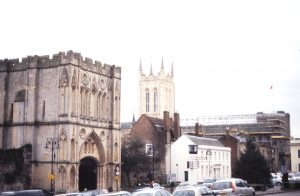
Abbey Gateway and Cathedral
When the Danes under Sweyn Forkbeard again threatened in 1010, Edmund's body was taken for safety to London where it remained for three years. On its return it rested for a night at the Saxon Church at Greensted, which still stands. To atone for Sweyn's impiety, his son Canute made additions to the abbey. From then on it prospered - the great abbey church being built between 1090 and 1222, until Thomas Cromwell's commission in 1535 sounded the death knell of the monasteries.
Today the ruins of the Abbey cover a large area in the historic centre of Bury on the west bank of the river Lark. A mixed array of ecclesiastical buildings in various states of repair is ranged along Angel Hill and Crown Street. Beyond this the extensive Abbey Gardens form a pleasant park. Display panels in the Abbey Gateway and the gardens tell the story of Edmund and the subsequent history of the Abbey. To the south, the former church of St James has been restored and enlarged as the Cathedral Church of St Edmundsbury (IP33 1LS). Next to this is the Norman Tower, behind which we can see the ruined west front of the abbey with later houses built into it, giving a bizarre architectural mixture, and at the southern corner is the church of St Mary.
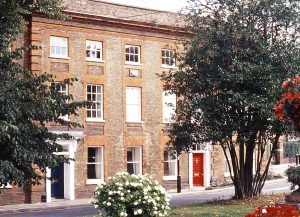
Thomas Clarkson's house
Edmund is not the only martyr remembered in Bury. Close to the Norman Tower, on the edge of a large cemetery, is a column erected in 1903 to commemorate seventeen men of the town who died as Protestants in Queen Mary's reign. Their names and trades are engraved on the sides. Even the accession of Queen Elizabeth did not put an end to persecution. For some, her protestant settlement did not go far enough and Elias Thacker and John Copping were hanged in the town in 1583 for distributing pamphlets by Robert Browne, the advocate of "separatism" or independency. In 1904, a smaller version of the martyrs' column was placed outside the United Reformed Church in Whiting Street in their memory.
In St Mary's Square (IP33 2AJ), a handsome three-storey Georgian building, now called Swan House, was once the home of the anti-slavery campaigner Thomas Clarkson (1760-1846).
HOXNE
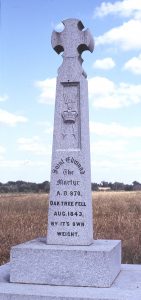
St Edmund's Cross
From the B1118 between Diss and Stradbroke, we turn down Low Street, cross the Swan bridge and come to the Goldbrook Bridge erected in 1878. On the bridge itself and on the village hall just beyond, stone tablets remind us that near this spot, St Edmund was taken prisoner and slain by the Danes in 870.
A little further on, a monument in a cornfield on the left marks the site of the oak tree, to which he was tied before being pierced with arrows and beheaded (IP21 5AL). Apparently, when the tree fell down in 1843, an arrowhead was found embedded in the trunk. Abbey Farm nearby is the site of the church where his body lay for 33 years before being taken to Bury St Edmunds.
Edmund (841-870), a contemporary of Alfred the Great, was born in Saxony, but adopted by King Offa of Mercia. He became the last king of East Anglia in 855, being crowned on Christmas Day at Bures. The defenceless kingdom had to meet the full onslaught of the Danish invaders and for ten years the young king bought peace for his people by paying heavy ransoms. Eventually the Danes could be bought off no longer. Following an indecisive battle at Thetford, Edmund was captured and, refusing to renounce his faith, brutally martyred. Some have suggested him as a more worthy candidate for patron saint of England than the dragon-slaying St George.
BURES
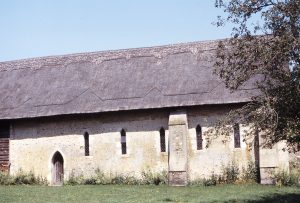
Chapel Barn, Bures
Known locally as the Chapel Barn, the church of St Stephen (CO8 5LD) is believed to stand on the site where Edmund was crowned king of East Anglia on Christmas Day in 855. The first problem is to find it. From the centre of the village, head north towards Sudbury, bearing right up Cuckoo Hill. At the top there is a track running between farm buildings and workshops and the chapel lies about half a mile down here, next to a farmhouse. Permission may be required to see inside. Founded by Archbishop Langton in 1218, it has a thatched roof and lancet windows, with memorials to the de Vere family inside. As the name implies, it was used for many years as a barn but restored and reconsecrated in the twentieth century.
HADLEIGH
The splendid church of St Mary (IP7 5DT), the ancient half-timbered Guildhall and the Tudor deanery tower form a kind of quadrangle around the churchyard, a quiet and peaceful spot at the centre of Hadleigh. But the tragic story it has to tell belies the beauty of the setting.
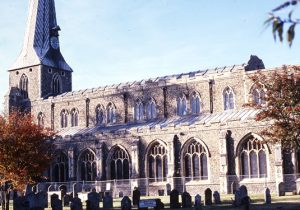
St Mary's, Hadleigh
In about 1544, Rowland Taylor was appointed rector by Archbishop Cranmer and served the town faithfully through the final years of Henry VIII and the reign of the boy king Edward VI. Little is known of Taylor's early life, but he had attended Cambridge University and imbibed the principles of the Reformation from the sermons of Hugh Latimer. Taylor was a faithful shepherd of his flock, expounding the scriptures, caring for the poor and sick and popular with the townsfolk.
With the accession of Queen Mary, the climate began to change. One day he encountered a Catholic priest celebrating mass in his church and a vigorous altercation ensued. This brought him to the attention of Bishop Stephen Gardiner and he was summoned to London. Declining the opportunity to flee to the Continent, Taylor left Hadleigh and did not return until the day of his death. Vilified and abused by Gardiner, he languished in prison for two years before being brought back to be burned at the stake on Aldham Common.
A stained glass window in the south chapel of St Mary's tells the story of Taylor's martyrdom. It has three panels, showing Taylor preaching, his trial, and finally being led to the stake with attendants carrying faggots.
The deanery tower, built by Archdeacon Pykenham in 1495, is only accessible by prior arrangement but a stairway up one of the turrets leads to a secret chamber, where Taylor is said to have hidden from his persecutors. Ironically it was also in this tower in the 1830s that Dean Rose convened a meeting that led the formation of the Oxford Movement. This was a High Church reaction to the principles of the Reformation for which Rowland Taylor had given his life.
The church is also believed to be the burial place of Guthrun, the Danish king, who accepted Christianity and was baptised after being defeated by Alfred at the battle of Ethandun and signing the Peace of Wedmore in 878.
ALDHAM
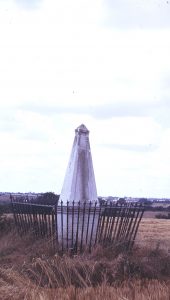
Rowland Taylor memorial
At the point where the road from Hadleigh meets the busy A1071 towards Ipswich is a white stone monument surrounded by iron railings. It is in a field set back from the road and a footpath continues to Aldham church a mile or so beyond. On the 9th February 1555, they dragged the saintly Rowland Taylor here at midnight to be burned at the stake. The time was chosen to avoid the anger of the local citizens. On arrival he asked What place is this? On being told it was Aldham Common, he exclaimed God be thanked. I am even at home. When asked to light the fire, one of the good men of Aldham pretended to be lame.
The monument (IP7 6BG) was erected in 1819. On one side is an inscription to Taylor, barely legible, stating that in defending what was good he at this place left his blood. It was restored in 1882, with a further inscription in memory of Richard Yeoman, Taylor's curate, who suffered the same fate at Norwich in 1558.
LITTLE BRADLEY
Tucked away down a narrow lane, a few miles north of Haverhill, is the little flint church of All Saints (CB9 7JD) with an unusual round tower. Here a colourful character from the Tudor period was laid to rest in 1584. He was John Daye, a printer with firm Protestant views, who printed John Foxe's Acts and Monuments, known to history as Foxe's Book of Martyrs. At one time Daye found himself in prison with John Rogers, vicar of St Sepulchre's Newgate, in whose parish he resided. Rogers was one of the first martyrs of Queen Mary's reign, but Daye survived and lived to print its greatest chronicle.
On the north wall of the sanctuary is a memorial brass with a punning rhyme beginning Here lies the Daye that darkness could not blind.... His other claim to fame is that he married twice and had thirteen children by each of his wives. Some of them appear on the brass; there was clearly not room for them all!
GROTON
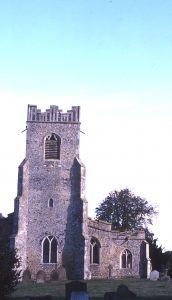
Groton church
The little church of St Bartholomew (CO10 5ED) is on the American Heritage Trail and each year receives a steady stream of transatlantic visitors. They come in search of John Winthrop (1588-1649) who was born at Edwardstone nearby and until the age of forty-two was Lord of the Manor of Groton and a prominent local figure. In 1630, his puritan views led him to seek freedom in the New World and he became founder of Boston and first governor of Massachusetts. Winthrop was married four times and his first two wives, Mary Forth and Thomasine Clopton are buried at Groton and have a memorial window in the chancel. The east window is a memorial to Winthrop himself, installed by his American descendants in 1875.
LAVENHAM
Probably no-one has counted, but there may well be more buildings here built before 1500 than after. With a wealth of half-timbered houses, shops and pubs, Lavenham is the archetypal picture-postcard English village. The Guildhall and the Old Grammar School, where John Constable was a pupil, are particularly impressive.
The church of St Peter and St Paul (CO10 9SA) is one of the finest in Suffolk, a county renowned for ecclesiastical splendour. The puritan William Gurnall (1617-1679) was vicar from 1644 until his death. He seems to have no memorial here, but a tombstone in the chancel records that Mary Boughton, who died in 1741, was Gurnall's granddaughter.
Gurnall was a preacher and writer who chose to abide by the Act of Uniformity of 1662, requiring clergy to adhere to the rubric of the Prayer Book. Some 2,000 of his brethren who dissented were turned out of their churches and lost their livings. Today Gurnall is chiefly remembered for his work The Christian in Complete Armour, published in three volumes between 1655 and 1662 and still in print.
PLAYFORD
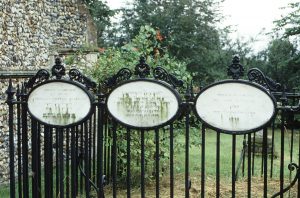
Clarkson graves, Playford
The village lies down narrow lanes not far from Woodbridge and in the churchyard lies Thomas Clarkson (1760-1846), lifelong campaigner against the slave trade, who lived at Playford Hall for the last thirty years of his life. At St Mary's Church (IP6 9DS), there is no tombstone but a wrought iron surround is inset with three white marble plaques recording the dates of Clarkson, his wife Catherine and son Thomas. Not far away is a tall obelisk to Clarkson Friend of Slaves, erected by his surviving friends in 1857.
HELMINGHAM
That robust Victorian evangelical John Charles Ryle was vicar here from 1844 to 1861 and a brass plaque records that he presented the church with its altar table. The church is dominated by memorials to the Tollemache family, who have lived in these parts for centuries. Their stately residence, Helmingham Hall, can be seen from the churchyard across a park full of deer (IP14 6EQ). In Ryle's time the squire was the autocratic first baron, John Tollemache. Ryle had to endure a long-running feud with this gentleman, who objected to the length and content of his sermons. The illuminated texts that decorate the church were apparently chosen by the squire's wife Georgina to add fuel to the dispute, but as a great lover of scripture, Ryle would have found little to complain about. Later, he found more peaceful pastures in the nearby parish of Stradbroke.
STRADBROKE
John Charles Ryle (1816-1900) came to All Saints church (IP21 4NQ) in 1861 and remained as vicar till 1880 when he was appointed the first Bishop of Liverpool. In the 1870s, he organised a complete restoration of the fabric of the church. Texts inscribed on the roof beams and over the chancel arch show clear evidence of his presence. A brass plaque over the vestry door records that the restoration was completed in 1879 in memory of his father, who had been MP for Macclesfield.
Altogether Ryle spent thirty-six years among the country people of Suffolk, which gave him a plain and straight-forward style in both speech and writing, free from theological abstractions. His works include Holiness and Practical Religion which are still read and valued today.
Stradbroke was also the birthplace in 1168 of the bishop and philosopher Robert Grossteste He became Bishop of Lincoln and Chancellor of Oxford University and was famous for his outspoken attacks on the excesses of the church. Monastic abuses, papal taxes, the pride and gluttony of religious houses - all came under his scrutiny. He even refused to ordain a nephew of the pope whom he considered unworthy for priestly office. A building called Town House stands on the site of his birthplace and he also appears on the village sign.


